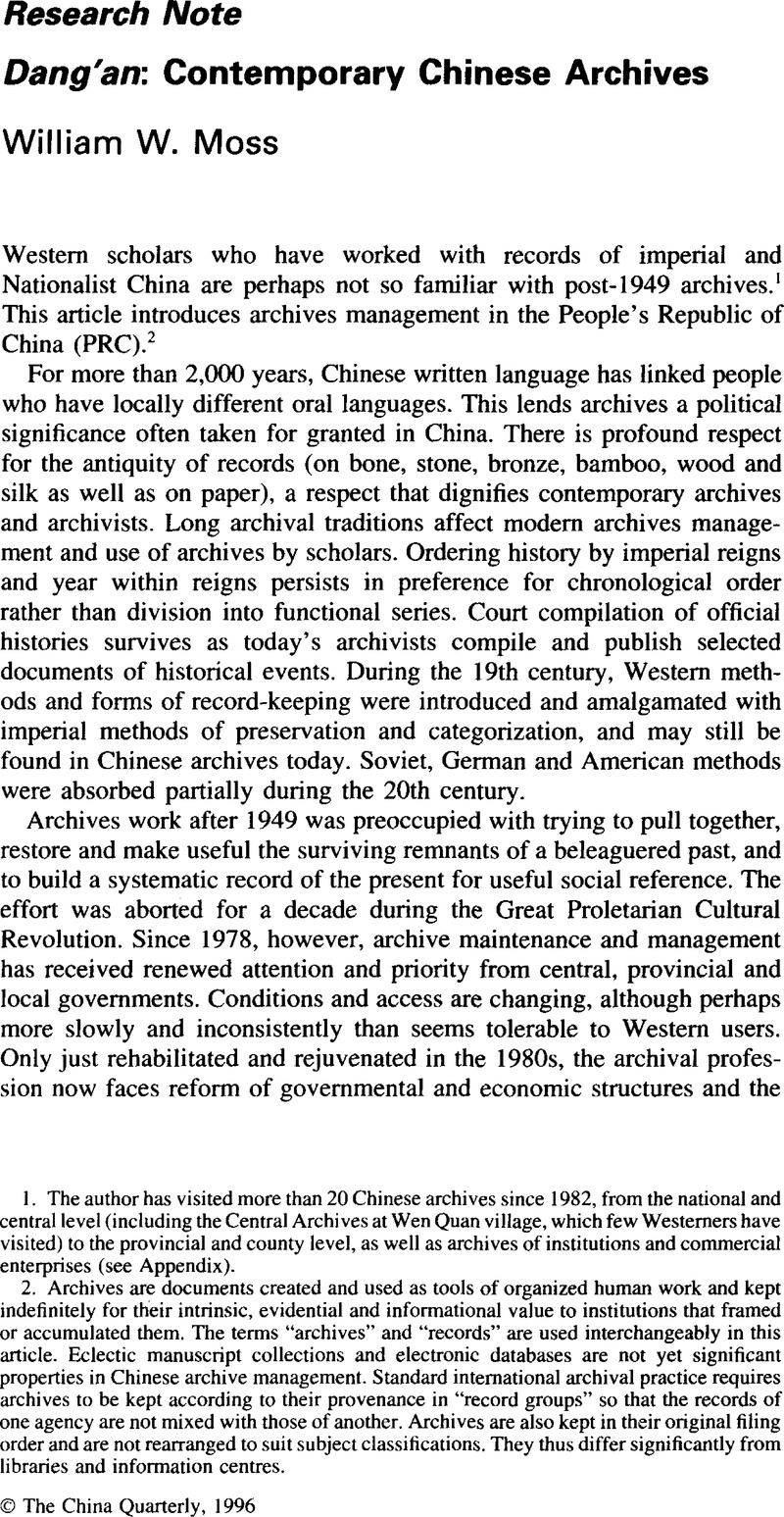Published online by Cambridge University Press: 12 February 2009

1 The author has visited more than 20 Chinese archives since 1982, from the national and central level (including the Central Archives at Wen Quan village, which few Westerners have visited) to the provincial and county level, as well as archives of institutions and commercial enterprises (see Appendix).
2 Archives are documents created and used as tools of organized human work and kept indefinitely for their intrinsic, evidential and informational value to institutions that framed or accumulated them. The terms “archives” and “records” are used interchangeably in this article. Eclectic manuscript collections and electronic databases are not yet significant properties in Chinese archive management. Standard international archival practice requires archives to be kept according to their provenance in “record groups” so that the records of one agency are not mixed with those of another. Archives are also kept in their original filing order and are not rearranged to suit subject classifications. They thus differ significantly from libraries and information centres.
3 Zou Jiawei, Dong Jian and Zhou Xueheng, Zhongguo dang'an shiye jianshi (A Brief History of China's Archival Profession) (Beijing: China People's University Press, 1985), pp. 235–36.
4 Events cited here and throughout, such as the establishment of the “Expropriation Work Commission,” are found not only in ibid,but also in a chronology found in Deng Lichun, Ma Hong and Wu Heng (eds.), Dangdai Zhongguode dang'an shiye (Contemporary China's Archival Profession) (Beijing: China Social Sciences Press, 1987), pp. 431–464.
5 A curious historical irony is that in the early 1960s a U.S. intelligence–gathering operation spent much time and effort collecting every scrap of material on a seemingly mysterious “third institute” of the Academy of Sciences, assuming that since its function remained stubbornly obscure it was undoubtedly of high military significance.
6 The journal was first issued in April 1951 under the titleZiliao gongzuo (Research Materials Work) as an “internal use only” document, and was not given broader circulation until 1957. Now publically available, the same journal was retitled Archives Workand then became Zhongguo dang'an (China Archives)in January 1994. It has been published by the State Archives Bureau since 1955.
7 “Guowuyuan guanyu jiaqiang guojia dang'an gongzuo de jueding” (“State Council decision on strengthening nation–wide archives work”), 16 April 1956, as printed in Zhonghua renmin gongheguo dang'an fagui huibian, 1949 nian 10yue 1992 nian 6yue (Compilation of Archives, Laws and Regulations of the People's Republic of China, October 1949–June 1992) (Beijing: Law Press, 1992), pp. 17–21.
8 “Zhongyang guanyu tongyi guanli dang, zheng dang'an gongzuo de tongzhi” (“Party central notice on unified management of Party and government records”), 7 January 1959, in Ibid.pp. 22–23.
9 “Guanyu jiefa dang'an gongzuozhong fandang fanshehuizhuyi heixian de tongzhi” and “Guanyu jieguan qingcha diwei dang'an de zhishi,” both cited by title without accompanying text in the chronology found in Dangdai Zhongguode dang'an shiye,p. 449.
10 Dangdai Zhongguode dang'an shiye,p. 449.
11 Apart from this information, gleaned in part from conversation with archivists, available sources, such as those cited in previous footnotes, tend to be silent on details of the effect of the Cultural Revolution on the archival establishment. For example, the foreword to Zhongguo dang 'an shiyejianshigives it passing mention as a period when archival research was “bogged down,” but offers no treatment of the period in the book's main text.
12 For a gist and commentary, see William W. Moss, “Archives Law of the People's Republic of China,” The American Archivist,Vol. 54, No. 2 (Spring 1991). For the Chinese text of the law and State Archives Bureau Order No. 1, seeZhonghua renntin gongheguo dang'anfagui huibian, 1949 nian 10 yue–1992 nian 6 yue, pp. 1–16. The Chinese texts of Order Nos. 2 and 3 may be found in Dang'an gongzuo,No. 2 (1992), pp. 7–8.
13 The figures are taken from a summary report on contemporary Chinese archival education presented by Chen Zhaowu, senior professor of the Archives College of China People's University and editor of Dang 'an tongxun (Archives Bulletin),at the Annual Meeting of the Society of American Archivists in Montreal, 1992. A copy of Chen's report and an English translation are in the possession of the author.
14 The organization described here is based on an organization chart and information provided by the Shandong Provincial Archives Bureau in 1992, and it is offered as only generally representative of component functions. Visits to other provincial and municipal bureaus indicate that other local variations exist.
15 Chen Zhaowu's report.
16 Zhang Manbiao and She Dongxuan, “We cannot weaken archives administration and management,” Zhongguo dang'an. No. 1 (1994), p. 17.